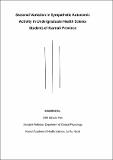Please use this identifier to cite or link to this item:
https://hdl.handle.net/20.500.14356/2723Full metadata record
| DC Field | Value | Language |
|---|---|---|
| dc.contributor.author | Pun, Dilli Bahadur | - |
| dc.date.accessioned | 2025-07-16T06:37:13Z | - |
| dc.date.available | 2025-07-16T06:37:13Z | - |
| dc.date.issued | 2025 | - |
| dc.identifier.uri | https://hdl.handle.net/20.500.14356/2723 | - |
| dc.description | Research report. | en_US |
| dc.description.abstract | Background: Seasonal variations in autonomic function have been linked to cardiovascular morbidity and mortality. The cold pressor test (CPT) and handgrip test (HGT) have been used in various studies to determine blood pressure (BP) regulation during stress, but their differential effects in various seasons are less explored. Thus, the study aimed to investigate seasonal differences in cardiovascular sympathetic activity in healthy young adults of Nepal. Methodology: This pre-test post-test study recruited 45 healthy students (55.6% female) aged 21.62±2.93 years, who underwent CPT and HGT interventions during summer and winter seasons. Blood pressure was measured before and after each intervention, and maximum voluntary contraction (MVC) was recorded during the handgrip test. The baseline systolic and diastolic blood pressure (SBP and DBP) and their rise during interventions were compared between summer and winter season. Result: Baseline BP were lower in summer than in winter season (SBP: 107.71±12.17 vs 120.78±11.31, p=0.001; DBP: 71.49±8.74 vs 77.60±8.83, p=0.001; paired t-test); but the mean maximum SBP and DBP during CPT and HGT was not significantly different between seasons. In CPT, there was a statistically significant rise in BP during summer compared to winter (SBP: 25.27±11.56 vs 13.84±11.17, p<0.001; DBP: 25.53±10.14 vs 13.51±7.15, p<0.001; paired t-test). Similarly, HGT also raised the BP higher in summer than winter (SBP: 35.07±17.11 vs 25.47±14.81, p=0.008; DBP: 30.96±12.12 vs 24.16±11.64, p=0.009; paired t-test); and was confirmed in linear regression analysis (p<0.01). Hyper responders (those with >21 mmHg rise in SBP) during CPT were higher in summer (22) than winter (10). Conclusion: This study demonstrates that while resting blood pressure is lower in summer, the sympathetic response to stress is heightened, indicating seasonal modulation of autonomic function, which may have implications for cardiovascular risk and adaptability to environmental changes. Keywords: Autonomic, Cardiovascular health, Cold pressor test (CPT), Handgrip test (HGT), Seasonal variation, Sympathetic activity. | en_US |
| dc.language.iso | en_US | en_US |
| dc.publisher | Research Center for Applied Science and Technology (RECAST) | en_US |
| dc.subject | Karnali Province | en_US |
| dc.subject | Autonomic, Cardiovascular health | en_US |
| dc.subject | Cold pressor test (CPT) | en_US |
| dc.subject | Handgrip test (HGT) | en_US |
| dc.subject | Seasonal variation, Sympathetic activity | en_US |
| dc.title | Seasonal variation in sympathetic autonomic activity in undergraduate health science students of Karnali province | en_US |
| dc.type | Research report | en_US |
| Appears in Collections: | NHRC Research Report | |
Files in This Item:
| File | Description | Size | Format | |
|---|---|---|---|---|
| RES_01212_PUN_2025.pdf | Full Text. | 1.31 MB | Adobe PDF |  View/Open |
Items in DSpace are protected by copyright, with all rights reserved, unless otherwise indicated.
